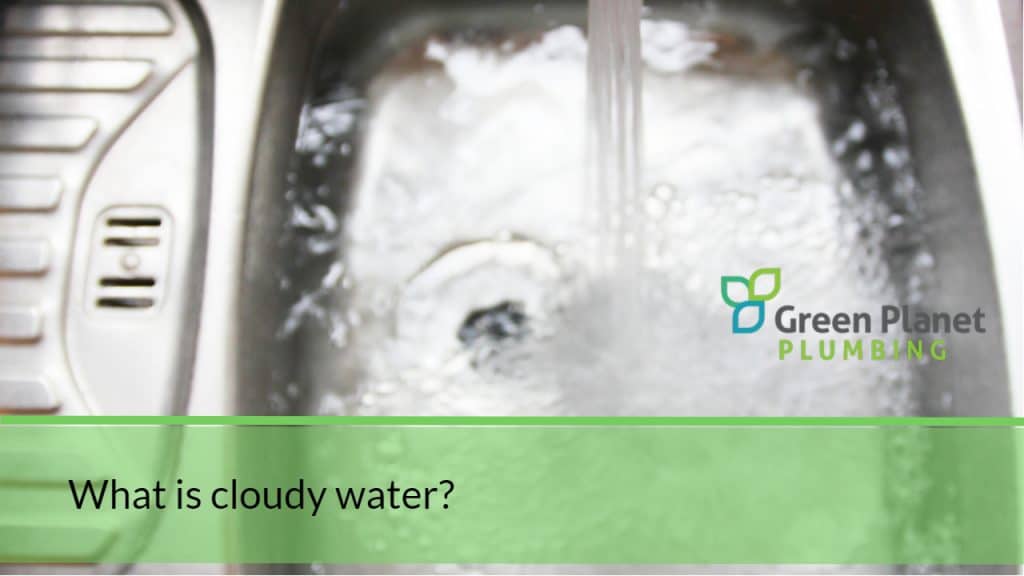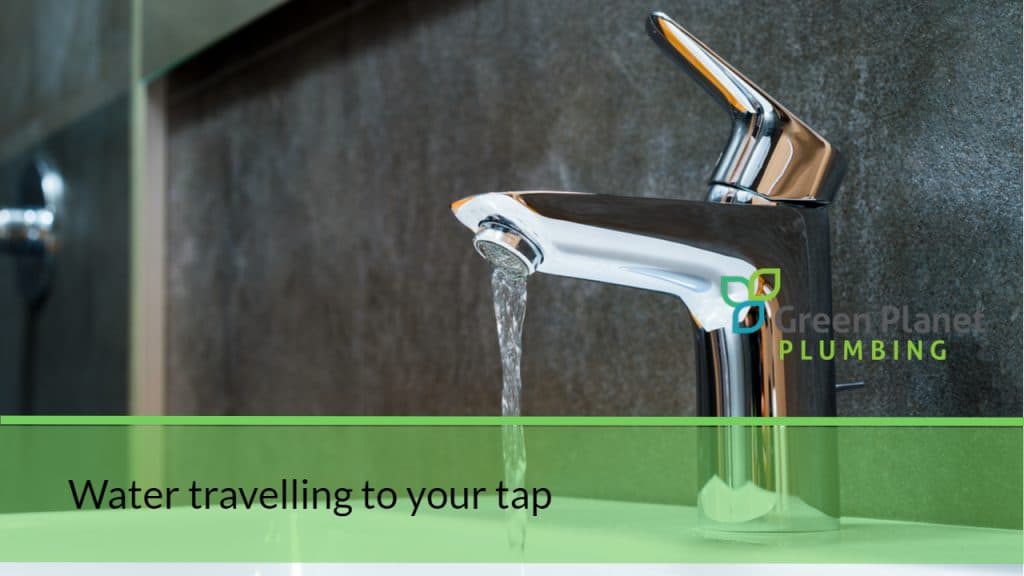Worried about your tap water being cloudy or milky? You’re not alone. Many people ask about this and Green Planet Plumbing are here to give you the answer! So, you can stop worrying about what you’re drinking, or avoiding. Cloudy water isn’t very appealing, so we understand your concern. We’ll guide you through why it happens, if it’s safe to drink or use, and how to prevent it from happening in the future.

What is cloudy water?
Water which is milky or cloudy in appearance is an uninviting drink compared to the crystal-clear water we would hope to consume.
The technical term for this cloudiness is called ‘turbidity’, which is a measure of the degree to which the water loses its transparency due to the presence of suspended particulates.
The measurement of turbidity is a key test of water quality, so how cloudy does water have to be before it becomes unsafe to drink? This is difficult to define as sometimes, even water at high turbidity levels doesn’t present a noticeable cloudiness and crystal-clear water doesn’t always necessarily equate to bug-free, safe water.
Cloudy water is generally due to any of the following:
- Air bubbles
- Hard water
- Total suspended solids (TSS) and turbidity
- Methane gas

1. Air Bubbles
In Australia, the most common reason for cloudy water is air bubbles. The cloudy water is due to harmless, tiny air bubbles being dispersed through the water. This can occur when air is trapped in the pipes after repair works. The problem generally goes away by itself in a short time, or may require the water main to be flushed.
Signs you have air bubbles in your water supply:
To check if air is in the water supply, fill a glass of water and let it sit for a few minutes. Watch the water. If the water clears from the bottom up and becomes completely clear after a few minutes, the problem is most likely just air bubbles. In order to alleviate the problem, run the front garden tap for a few minutes. If the problem doesn’t clear then your water supplier or plumber should be called to flush the water main or install an air elimination valve.
Excess air bubbles can get into your water supply due to:
- Trapped air in your plumbing
- Recent plumbing work
- Increased water pressure in your home’s plumbing
Air bubbles in water are harmless. If, however, the water doesn’t clear, contact your local plumbers.

2. Hard water
When it comes to water, hardness is a measure of the presence of calcium ions, as well as other ions such as magnesium, iron, and manganese. Hard water can cause scale to form on boilers, hot water pipes, and fittings. To minimise undesirable build-up of scale in hot water systems, total hardness (as calcium carbonate – CaCO3) in drinking water should not exceed 200 mg/L.
Other things can also influence the effects of hardness. These include the type of minerals present, alkalinity, dissolved oxygen, and temperature. If these other factors combine, water can become corrosive if it’s too soft.
Signs you have hard water:
- Mineral build-up around water fixtures and appliances
- White spots on glass dishes after washing them
- You’re using extra laundry detergent otherwise your clothes are stiff and discoloured
- Cloudy water in a glass never disappears
Virtually all drinking waters available on the east coast of Australia can be described as either soft or of ‘good quality’ and the table below shows that all Hunter Water sources fall into this category.

How to fix hard water:
Have a plumber install a whole-home reverse-osmosis filtration system. These systems are a safe and effective way to remove the extra minerals in your water to make your water less cloudy. A reverse-osmosis filtration system also removes harmful chemicals or bacteria that have made their way into your water.
3. Total suspended solids (TSS) and turbidity
High total suspended solids (TSS) in water can often mean higher concentrations of bacteria, nutrients, pesticides, or metals in the water.
Signs you have a high level of TSS in your water:
- Water becomes clear after passing through a standard filtration system
- There has recently been disturbance or construction near your water supply.
TSS is small solids that stay suspended in the water; they don’t ever settle to
the bottom. Some of these solids include: silt, sediment, clay, iron, manganese
and algae.
Although the Environmental Protection Agency (EPA) doesn’t provide a standard for TSS measurement in drinking water, unusual cloudiness due to TSS can lead to bacteria growth.
How to get rid of TSS in your water:
Use a standard cartridge or bag water filter for moderate cloudiness. For more severe cloudiness, you may need to use a multi-level media water filtration. Talk to your local plumber today to discuss the best solution for your water system.

4. Methane gas
Methane is a natural gas that can occur naturally in well water. This gas is a colourless, odourless gas that is lighter than air. Natural gas is mostly methane (70 – 90 % CH4), carbon dioxide (0 to 8 % CO2), plus other gases.
This is a rarer and more dangerous cause of cloudy drinking water. The first
thing you should do if you suspect this is to have your water tested by a
professional. The level of methane matters. In the meantime, ensure you have
good ventilation when you turn on your faucet to run the dishwasher or washing
machine.
Signs you have methane gas in your faucet water:
- White air bubbles in your water
- You use well water
- Water sputtering from your faucet
Read more about the chemical guidelines and standards for drinking water in Australia here.
How to get rid of methane gas in your faucet water:
If you think you have methane gas in your drinking water, you’ll want to have a professional test the water to measure the exact methane gas levels.

Water Purification
How does water purification work?
The process of water purification makes water look crystal clear and gives some degree of assurance to the engineers that most microorganisms have been removed.

Research into cloudy water and ‘turbidity’
Researchers at Drexel University in the United States conducted a review of epidemiological studies and found a link between cloudy tap water and gastrointestinal illness (although the link isn’t very straightforward).
The review of epidemiological studies looked at the association between turbidity of drinking-water supplies and incidence of acute gastrointestinal illness (AGI).
Environmental and Occupational Health Associate Professor Dr. Anneclaire De Roos stated that:
“more than 10 studies found a link between water turbidity and AGI incidence. These results suggest that exposures through drinking water caused a low but detectable number of AGI cases in the regions and time periods studied. There is no clear, alternative explanation for the patterns of associations — particularly when a similar pattern was seen multiple times.”
The remaining studies show discrepancies, suggesting that turbidity can indicate a number of different things. For example, in raw water, before purification, high turbidity means high levels of microorganisms, but there may be no correlation between the levels of turbidity and microorganisms in the purified water that is supplied to our homes. A range of other factors including seasonal changes in water bodies, may influence the levels of turbidity and microorganisms in water.
“While these types of epidemiologic studies can’t give definitive answers, they offer a relatively inexpensive tool for screening water supplies in order to prioritize management strategies and further research,” Dr. De Roos said.
Acute gastrointestinal illness could be caused by bugs like norovirus, Giardia, or Cryptosporidium and carry symptoms like diarrhea and vomiting. Cases linked to water systems have been estimated at between 12 and 16.4 million annually in the United States alone.
Overall, the authors of the study concluded that cloudiness alone can’t be used as an indicator for predicting endemic gastrointestinal illnesses. So, don’t immediately freak out if you have cloudy water, it won’t necessarily give you gastro.
It makes sense for the water utilities and process engineers to treat water cloudiness as an indirect indicator of potential bug presence in the water at the water treatment works because, in the raw water, both microorganisms and fine particles are present and assumed to be represented by the numerical value of the turbidity.

Water travelling to your tap
Water from the tap comes after travelling through kilometres of water supply pipe networks – and it might pick up cloudiness on the way from broken pipes with or without picking up bugs. There are also local sources of harmless cloudiness in the tap water, for example, scaling in domestic water pipes.
If the tap water looks cloudy, it may still be free from bugs responsible for gastrointestinal illnesses. Unfortunately, without carrying out laboratory testing for tap water samples in your home, it is impossible to confirm the presence of bugs in the water, regardless of how it looks.

Is Cloudy Water Safe to Drink or Use?
We’ve outlined the different possible causes of cloudy water, most of which are safe, despite the unappealing cloudiness. The more dangerous causes such as methane gas are rarer, and can be more obvious. However, if you are concerned, it’s important you have your water tested by a professional so you can put your worries to rest, or determine the problem and, with the help of professional plumbers, find a solution. The most common cause of cloudy or milky water is due to trapped air or a build-up of dissolved particles in the water pipes, which are completely harmless.
Call a professional plumber to check your water faucets and determine the best solution.

